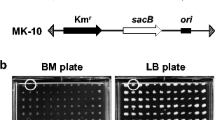Abstract
The hmc operon of Desulfovibrio vulgaris subsp. vulgaris Hildenborough consists of six genes (hmcA to hmcF) that encode structural components of the high-molecular-mass cytochrome redox protein complex (the Hmc complex). Two genes (rrf1 and rrf2) encoding regulatory proteins are present downstream of hmcF. Expression of the hmc operon, monitored by incubating protein blots with HmcA-specific or HmcF-specific antibodies, was found to be highest when hydrogen was the sole electron donor for sulfate reduction. Use of lactate or pyruvate as electron donor reduced expression of the hmc operon. A mutant with a deletion of the rrf1 and rrf2 genes was generated with the sacB mutagenesis method. This mutant overexpressed the hmc operon approximately threefold. It grew more rapidly than the wild type when hydrogen was used as the electron donor for sulfate reduction, but more slowly than the wild type when lactate was used. The results indicate that a physiological function of the Hmc complex is in electron flow from hydrogen to sulfate. At least one redox carrier is shared competitively by the hydrogen and lactate oxidation pathways in D. vulgaris.
Similar content being viewed by others
Author information
Authors and Affiliations
Additional information
Received: 9 October 1996 / Accepted: 18 February 1997
Rights and permissions
About this article
Cite this article
Keon, R., Fu, R. & Voordouw, G. Deletion of two downstream genes alters expression of the hmc operon of Desulfovibrio vulgaris subsp. vulgaris Hildenborough. Arch Microbiol 167, 376–383 (1997). https://doi.org/10.1007/s002030050458
Issue Date:
DOI: https://doi.org/10.1007/s002030050458




